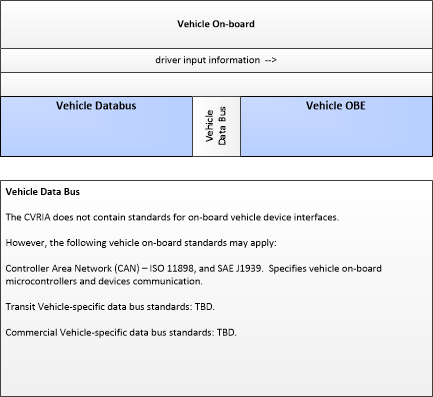Link Type: Vehicle On-Board
Vehicle Databus --> Vehicle OBE:
driver input information
Definitions
driver input information (Information Flow): Driver input received from the driver-vehicle interface equipment via the vehicle bus. It includes configuration data, settings and preferences, interactive requests, and control commands for the connected vehicle on-board equipment.
Vehicle Databus (Source Physical Object): The 'Vehicle Databus' represents the interface to the vehicle databus (e.g., CAN, LIN, Ethernet/IP, FlexRay, and MOST) that may enable communication between the Vehicle OBE and other vehicle systems to support connected vehicle applications. The vehicle system statuses and/or sensor outputs available on the databus will vary based on the equipment installed on the vehicle and availability on databus. System statuses and sensor outputs may include select vehicle systems and sensors such as accelerometers, yaw rate sensors, and GPS derived location and timing information. In CVRIA, this physical object is used to represent the onboard interactions between the Vehicle OBE and the other systems included in a host vehicle.
Note that the vehicle databus interface is not standardized across all vehicle classes. Also, some Vehicle OBE implementations will not have access to the vehicle databus. See 'Vehicle OBE' for more information.
Vehicle OBE (Destination Physical Object): The Vehicle On-Board Equipment (OBE) provides the vehicle-based processing, storage, and communications functions necessary to support connected vehicle operations. The radio(s) supporting V2V and V2I communications are a key component of the Vehicle OBE. This communication platform is augmented with processing and data storage capability that supports the connected vehicle applications.
In CVRIA, the Vehicle OBE includes the functions and interfaces that support connected vehicle applications for passenger cars, trucks, and motorcycles. Many of these applications (e.g., V2V Safety applications) apply to all vehicle types including personal vehicles, commercial vehicles, emergency vehicles, transit vehicles, and maintenance vehicles. From this perspective, the Vehicle OBE includes the common interfaces and functions that apply to all motorized vehicles.
Included In
This Information Flow is in the following Applications:
- Advanced Automatic Crash Notification Relay
- Advanced Traveler Information Systems
- Connected Eco-Driving
- Cooperative Adaptive Cruise Control
- Curve Speed Warning
- Do Not Pass Warning
- Dynamic Eco-Routing
- Eco-Approach and Departure at Signalized Intersections
- Eco-Cooperative Adaptive Cruise Control
- Eco-Lanes Management
- Eco-Ramp Metering
- Eco-Speed Harmonization
- Eco-Traffic Signal Timing
- Electric Charging Stations Management
- Intelligent Traffic Signal System
- Intermittent Bus Lanes
- Low Emissions Zone Management
- Queue Warning
- Reduced Speed Zone Warning / Lane Closure
- Restricted Lane Warnings
- Road Weather Motorist Alert and Warning
- Speed Harmonization
- Spot Weather Impact Warning
- Variable Speed Limits for Weather-Responsive Traffic Management
- Vehicle Emergency Response
This Information Flow is in the following Application Objects:
- Vehicle Basic Safety
- Vehicle Electric Charging Assist
- Vehicle Emergency Notification I/F
- Vehicle Environmental Monitoring
- Vehicle Interactive Traveler Information
- Vehicle Mayday Notification
- Vehicle Payment Service
- Vehicle Queue Warning
- Vehicle Restricted Lanes Application
- Vehicle Roadside Information Reception
- Vehicle Speed Management Assist
- Vehicle Trip Planning and Route Guidance
Communication Diagrams
The communication diagram(s) can be viewed in SVG or PNG format and the current format is SVG. Switch to PNG format.
Characteristics
Architectural:
| None defined |
Security
This information flow triple is in the following applications with the following security levels.
| Information Flow Security | |||||
|---|---|---|---|---|---|
| Application | Confidentiality | Integrity | Availability | ||
| Basis | Basis | Basis | |||
| Security levels have not been defined yet. | |||||
